Project Log: Wednesday, December 15, 2010
I had an hour or so available at the end of the work
day, so I thought I'd see if I could successfully
separate the glued-up and broken (or nearly so) sections
of the teak external bulwark cover boards.
As you may recall, during the removal of these pieces
from the port side of the boat, I discovered that the
forward sections had been secured with an overabundant
application of nasty adhesive sealant, which complicated
the removal and unfortunately caused damage to the
boards right at their after ends where they met the next
section with half-lap joints.
In one case, the board broke completely just forward of
the half-lap, as seen below; in the two other cases, I
managed to get the boards--still glued together at the
joints--off the boat intact, but with cracks already
forming from the stress, so all three sets of boards
would require repair (at best) or replacement (hopefully
not). |
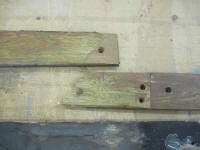 |
Since the insides of these half-laps were heavily
slathered in the black sealant, I worried about how to
separate the pieces. I needed to separate the
joints to make the board sections more manageable and
avoid further damage now and in the future, during the
repair process (hopefully), the sanding and refinishing
process (assuming the repairs could be effected
successfully), and reinstallation.
To separate the joints, I used a thin cutting blade in
my oscillating multi-tool, a special-purpose tool that
had been slowly starting to prove its occasional worth
in the shop, to my grudging surprise. Starting
with the boards that had already broken (as seen
in the photo above), I used a slim pull saw to cut
through the exposed vertical glue line on the face of
the board, demarking the end of the half-lap, then used
the multi-tool to carefully cut through the sealant (aka
black gunk) that was holding the pieces of wood together
within. This worked quite well. |
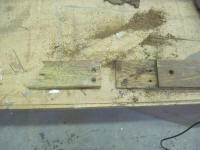
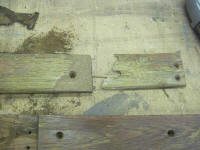 |
Despite the ragged appearance of the break, it was
actually a surprisingly clean break in that the two
pieces slotted together neatly with barely any sign of
the damage. While in an ideal world I'd just throw
out this wood and start over with new, I really, really
did not want to do so: these boards looked like an
annoying and time-consuming job to replace, never mind
the cost of the new teak.
Structurally, the broken areas of these boards were
insignificant; these are just trim pieces for the most
part, and the broken areas were located well away from
the open freeing ports that the board span. So given the
cleanness of the break, I thought I'd have nothing to
lose by attempting a repair.
Pleased so far with the joint separation process, I
moved on to the other two long sections and managed to
separate the joints in the same way. Both of these
sections were also already damaged from the removal from
the boat, and another one of the boards broke just past
the joint as I worked to separate the glue. Again,
however, I felt that the break--ragged as it
appeared--slotted together neatly with its counterpart,
and I decided to glue it up and see what happened. |
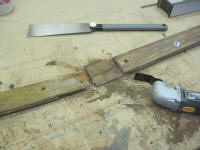
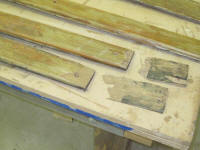 |
Several of the other boards had small cracks here and
there, most of which had been there for some. To
preserve the boards and prevent further damage, I
planned also to glue these cracks to the extent
possible. While these cracks might never be truly
invisible, they were insignificant and I wasn't about to
trash the boards because of these minor areas. Of
course, if later in the process I were to discover that
these teak board didn't clean up as I hoped, then all
bets would be off. |

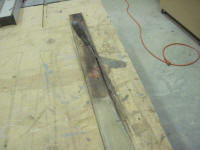

 |
After inspecting all 18 boards that came off the boat, I
had a small pile of about six that required repair in
some form or another. I cleaned the mating
surfaces (where possible) with acetone, and glued
everything together with a slightly thickened epoxy
resin mixture, using tape and clamps as needed to hold
the glued-up joints together. and set the pieces aside
to cure.
Everything looked like a royal mess, but I'd confidence
that once the boards were sanded and cleaned up, the
glue joints would be barely noticeable and structurally
sound enough for the boards' intended position. |
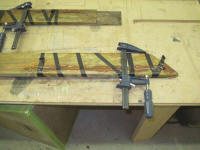
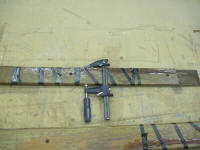
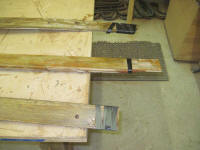

|
Total Time Today: 1 hours |
<
Previous |
Next > |
|
|














